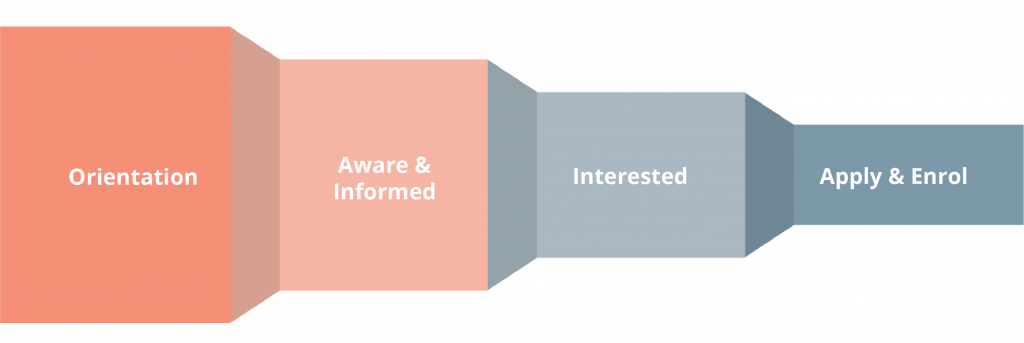The key to effective international recruitment: Stay laser-focused on your students
As marketers, oftentimes we think in terms of campaigns. We toil away at elaborate campaigns, push out and evaluate them only to start over from scratch.
We employ a good mix of inbound marketing, paid traffic and partner referrals, write blog posts, invest in pay-per-click ads, send newsletters, and tweet to our heart’s content. That only takes us so far.
Here’s the thing: If you run a campaign without having a clear direction, you’ll end up wasting two of your university’s most valuable assets: time and money. So, you ought to step outside of the operational work occasionally, stop thinking in short-term campaign chunks and look at the bigger picture.
Student recruitment is strategic. It doesn’t matter if you’re a beginner or an advanced student recruiter, you need to focus on your goals as much as possible. To get your student recruitment strategy to the next level, you need to start thinking in terms of systems, and from there build a recruitment machine.
You need a scalable, replicable framework that doesn’t work for just one course, but for potentially hundreds. An effective growth framework is one where student needs and institutional goals intersect. Your students and prospective students are the lifeblood of your institution. You need to build your recruitment strategy around them. Step #1 of recruiting students is understanding who they are.
Recruitment starts with your students
Every recruitment strategy should start with your student base. Who is enrolling at your university? There are over 4.5 million internationally-mobile students around the world. Why did some choose your university over the thousand other options available to them?
Before jumping into your international student recruitment strategy, have a conversation with your current international students.
How did they find out about your university and programmes? What was the process that transformed them from interested students into applicants and, eventually, into enrolled students? What kinds of things did they take into consideration? Choosing an international study programme is one of the most important decisions any of your students have taken, so why not take time to understand how they chose you?
Chances are that the answers to these questions have little to do with whether your students found your university and programme online or in-person. Recruiting students is about relationships and these can happen through both online and offline media. What you’ll likely hear and find most compelling are stories about how your university solved some of your students’ most pressing problems and questions. Note them down.
Develop your student personas
Now that you have a solid grasp of who your students are and what makes them tick, it’s time to leverage this information to your team’s advantage. However, you’ve probably realised that your students are highly diverse and have their own unique preferences, personality traits, and needs. That’s a challenge if you like to run an international strategy.
You have to start looking for the patterns: the shared behaviours and values that best describe your students – and organize them into a few strategic personas. Going deeper into dissecting your student body, step #2 of recruiting the best-fitting students is developing your student personas.
Student personas are fictional, generalized sketches which represent the typical and most common behavioural, demographic, and psychological characteristics of your students. They can help you tailor your marketing message and value proposition for each key student segment, based on what they really need.
Remember, when thinking about moulding your student body into personas, your core student segments should be unique to your university or faculty. A quick way to get started is to complete the international student persona canvas.
Know your students’ paths to enrolment
Knowing your students is not enough. You also need a thorough understanding of how their values, behaviour, and personality traits translate into enrolments at your university. A key place to start is your university’s communication and marketing team. Even if you do not yet have a recruitment strategy in place, you can start to identify areas where connection-building efforts are already strong.
Here are some key questions to address in this process:
1. What are the most common ways your students find out about programmes at your university?
Word of mouth? Referrals? Search engines?
Choose recruitment initiatives that amplify what’s already working. If you detect significant growth due to personal references, you may consider implementing a referral programme among your students to incentivize more opportunities. If there is one particular channel that delivers the best traffic, consider increasing your investments in it. If you host an event that delivers a high volume of quality students, consider making an even bigger splash next time.
2. What are some of the initial questions students are asking?
When you address this question, incorporate the answers into your recruitment messages and value propositions up-front. This method enables you to anticipate what your prospective students want to know, thereby building a strong, mutual connection.
3. Do you have materials guiding students through each funnel stage? What follow-up questions are they asking and what types of concerns are built into conversations about your programmes and universities?
The decision-making process for international students is rather long; and their process for selecting a university choice happens incrementally, over months (and sometimes years). Your materials should guide prospective students seamlessly through each stage in that decision-making process, in order to optimise your communication and mobilise them from prospects to eventual enrolments.
4. How long does the overall study choice process take? About how much time is required for each stage?
Your recruitment initiative should be measurable in a way that allows you to assess the ROI. You’ll need to make this judgement call at just the right time. If you attempt to measure too early, you may not have enough data to truly understand how successful your strategy actually is. If you measure too late, your university may lose students and revenue due to a delay in responding quickly enough. The best approach is to be realistic about your timing. That way, you won’t risk making decisions too late or too soon.
5. What are common reasons why students don’t enrol? Is there a lack of fit between your university programme and their individual needs?
Student drop-off can happen at every stage of the study choice process. By addressing problem areas, your university will be well-positioned to keep prospective students engaged longer.
Evaluate your university’s conversion funnel
The conversion funnel is one of the most important concepts utilized in online student recruitment. In a nutshell, it’s a diagram that illustrates how your recruitment paves the student’s path from searching to interest, then from applying to enrolment. This concept is so important that we keep on mentioning and linking it across a number of our articles and guides.
Keep in mind that conversion funnels vary between programmes, institutes, and user segments. Your university will likely have more than one of these.
This tool should help you visualise and understand student behaviour at every stage of the study choice. A sizeable portion of your website visitors will eventually follow this path so that you can reach your final marketing goal. An even bigger portion won’t.
Drop-off at every stage of the funnel is normal. The key is to understand why drop-off happens and to try to minimize it.
So, get together with your team and gather everyone back at the drawing board (literally). Conversion funnel diagrams are invaluable tools for piecing together a comprehensive view of your students’ motivations and path to enrolment.
Whatever you do, don’t copy other universities’ diagrams. Your conversion funnel should be unique in such a way that your recruitment team develops strategies in tandem with the specifics of your university’s marketing and communication structure.
One point of caution is to be connections-minded. Whatever you do, don’t get bogged down by anatomical details. The conversion funnel describes a process; but more importantly, it is a means of forging human relationships between your university and your students. No matter what you read or what advise you hear, remember that you are always, absolutely, and undoubtedly talking about people.
Conversion funnels are just as much about emotions as they are about logical decisions. Make sure that you evaluate, analyse, and pay close attention to both.
Know where online student recruitment fits in
Typically, universities leverage online student recruitment resources to accomplish the following types of goals:
- Build awareness about the university or its programmes.
- Engage prospective students at the opposite ends of the interest spectrum: when they’re most intrigued and when they’ve gone cold.
- Grow engagement with existing prospective students.
All three of these aims carry you through the funnel so that you arrive at the goal of student enrolments.
For more updates, follow us!







